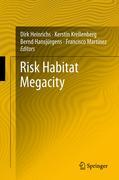
Risk habitat megacity
Heinrichs, Dirk
Krellenberg, Kerstin
Hansjürgens, Bernd
Martínez, Francisco
Megacity development and the inherent risks and opportunities for humans and the environment is a theme of growing urgency in the 21st century. Focusing onLatin America where urbanization is most advanced, this book studies the complexity of a ‘mega-urban system’ and explores interrelations between sectors and issues by providing an in-depths study of one particular city, Santiago de Chile. The book attempts to (i) focus on the emergence of risk in megacities byanalyzing risk elements, (ii) evaluate the extent and severity of risks, (iii) develop strategies to cope with adverse risks, and (iv) to guide urban development by combining concepts with empirical evidence. Drawing on the work of an interdisciplinary and international consortium of academic and professional partners, the book is written for scholars in cross-cutting areas of urban, sustainability, hazard, governance and planning research as well as practitioners from local, regional and international organizations. Provides an indicator-based state-of-the-art comparison of six megacities in Latin America. Explores scenarios for development trends of Latin America megacities until 2030. Offers an indisciplinary and comprehensive perspective on risks and opportunities in the Metropolitan Region of Santiago de Chile. Provides implementation knowledge in a wide range of urban sectors and policy fields. INDICE: Foreword. Part I: A Challenge for Research and Implementation. Part II: Developing the Conceptual Framework. Part III: Exploring Policy Fields. Part IV: Synthesis and Perspectives.
- ISBN: 978-3-642-11543-1
- Editorial: Springer Berlin Heidelberg
- Encuadernacion: Cartoné
- Páginas: 363
- Fecha Publicación: 30/09/2011
- Nº Volúmenes: 1
- Idioma: Inglés
